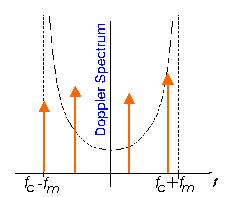
Animation of Rayleigh fading
In this JAVATM applet, Rayleigh fading is simulated
by taking four reflected and scattered waves.
Their relative amplitudes are 0.574, 0.533, 0.462 and 0.417. The Doppler shifts are
chosen to lead to a Doppler spread of 1 Hz.
This a relatively slow type of fading, that could occur in an indoor
propagation environment. Often Doppler spreads of 50 - 100 Hz are
experienced in vehicular reception above 1 GHz.

Figure: Approximation (orange) of Theoretical Doppler Spectrum (Black)
We took
- + 0.9 Hz, this would correspond to a wave arriving from 25 ° relative to the motion of the vehicle.
- - 0.62 Hz, angle of arrival 128 °
- + 0.21 Hz, angle of arrival 78 °
- - 1 Hz, the largest shift of all, angle of arrival -180 °, i.e., from behind the vehicle.
Note that in a typical Doppler spectrum, shifts of about the maximum value are more likely
than shifts nearer to 0 Hz.
Java Applet: Phasor diagram of 4 scattered waves (in blue),
resulting an approximately Rayleigh-fading envelope (in black).
More on simulating Rayleigh fading






